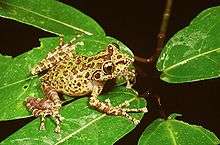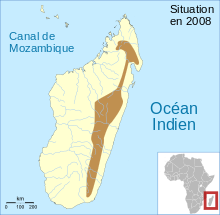Spinomantis peraccae
Spinomantis peraccae is a species of frog in the mantellid subfamily Mantellinae. It is endemic to Madagascar and widely distributed in the northern, eastern, and central parts of the island.[1][2] The specific epithet honours Italian herpetologist Mario Giacinto Peracca.[3] Common name Peracca's Madagascar frog has been coined for it.[1][2]
| Spinomantis peraccae | |
|---|---|
 | |
| Scientific classification | |
| Kingdom: | Animalia |
| Phylum: | Chordata |
| Class: | Amphibia |
| Order: | Anura |
| Family: | Mantellidae |
| Genus: | Spinomantis |
| Species: | S. peraccae |
| Binomial name | |
| Spinomantis peraccae (Boulenger, 1896) | |
 | |
| Synonyms[2] | |
| |
Taxonomy
George Albert Boulenger described this species in 1896 within the genus Rhacophorus.[4] Rose M. A. Blommers-Schlösser transferred it to Mantidactylus in 1978.[5] Alain Dubois placed it in the then-subgenus Blommersia in 1992,[6] but it was moved to the then-subgenus Spinomantis by Glaw and Vences in 1994.[7]
Description
Adult males measure 34–44 mm (1.3–1.7 in) and adult females 39–45 mm (1.5–1.8 in) in snout–vent length. The snout is rounded. The tympanum is distinct and supra-tympanic fold is prominent. The fingers have expanded discs but no webbing; the toes are webbed but the discs are smaller than those on the fingers. The dorsum is brownish-greenish and has darker blotches. Dorsal skin is rather warty with dark, protruding dots. The lower parts are whitish; there are few dark spots on the throat.[8]
Geographic range
It is endemic to the eastern half of Madagascar.[1][2]
Habitat
Spinomantis peraccae occurs in pristine rainforest along streams at elevations of 500–2,000 m (1,600–6,600 ft) above sea level. It is arboreal. The eggs are laid on leaves above water. The tadpole develop in slow-flowing streams.[1]
Conservation status
Spinomantis peraccae is a locally abundant species, but it is suffering from habitat loss. It occurs in many protected areas. Because of its wide range and large overall population, it is not considered threatened.[1]
References
- IUCN SSC Amphibian Specialist Group (2016). "Spinomantis peraccae". IUCN Red List of Threatened Species. 2016: e.T57510A84175192. doi:10.2305/IUCN.UK.2016-1.RLTS.T57510A84175192.en.
- Frost, Darrel R. (2017). "Spinomantis peraccae (Boulenger, 1896)". Amphibian Species of the World: an Online Reference. Version 6.0. American Museum of Natural History. Retrieved 7 December 2017.
- Beolens, Bo; Watkins, Michael & Grayson, Michael (2013). The Eponym Dictionary of Amphibians. Pelagic Publishing. p. 165. ISBN 978-1-907807-42-8.
- Boulenger, G. A. (1896). "Descriptions of two new frogs obtained in Madagascar". Annals and Magazine of Natural History. Series 6. 18 (107): 420–421. doi:10.1080/00222939608680479.
- Blommers-Schlösser, R.M.A. (1978). "Cytotaxonomy of the Ranidae, Rhacophoridae, Hyperoliidae (Anura) from Madagascar with a note on the karytotype of two amphibians of the Seychelles". Genetica. 48: 23–40. doi:10.1007/bf00125283.
- Dubois, A. (1992). "Notes sur la classification des Ranidae (Amphibiens anoures)" (PDF). Bulletin Mensuel de la Société Linnéenne de Lyon. 61 (10): 305–352. doi:10.3406/linly.1992.11011.
- Glaw, Frank & Vences, Miguel (1994). A Fieldguide to the Amphibians and Reptiles of Madagascar (2nd ed.). Cologne, Germany: Vences & Glaw Verlags GmbH.
- Andreone, F.; Glaw, F.; Vences, M. & Vallan, D. (1998). "A new Mantidactylus from south-eastern Madagascar, with a review of Mantidactylus peraccae (Ranidae: Mantellinae)". Herpetological Journal. 8: 149–159.
